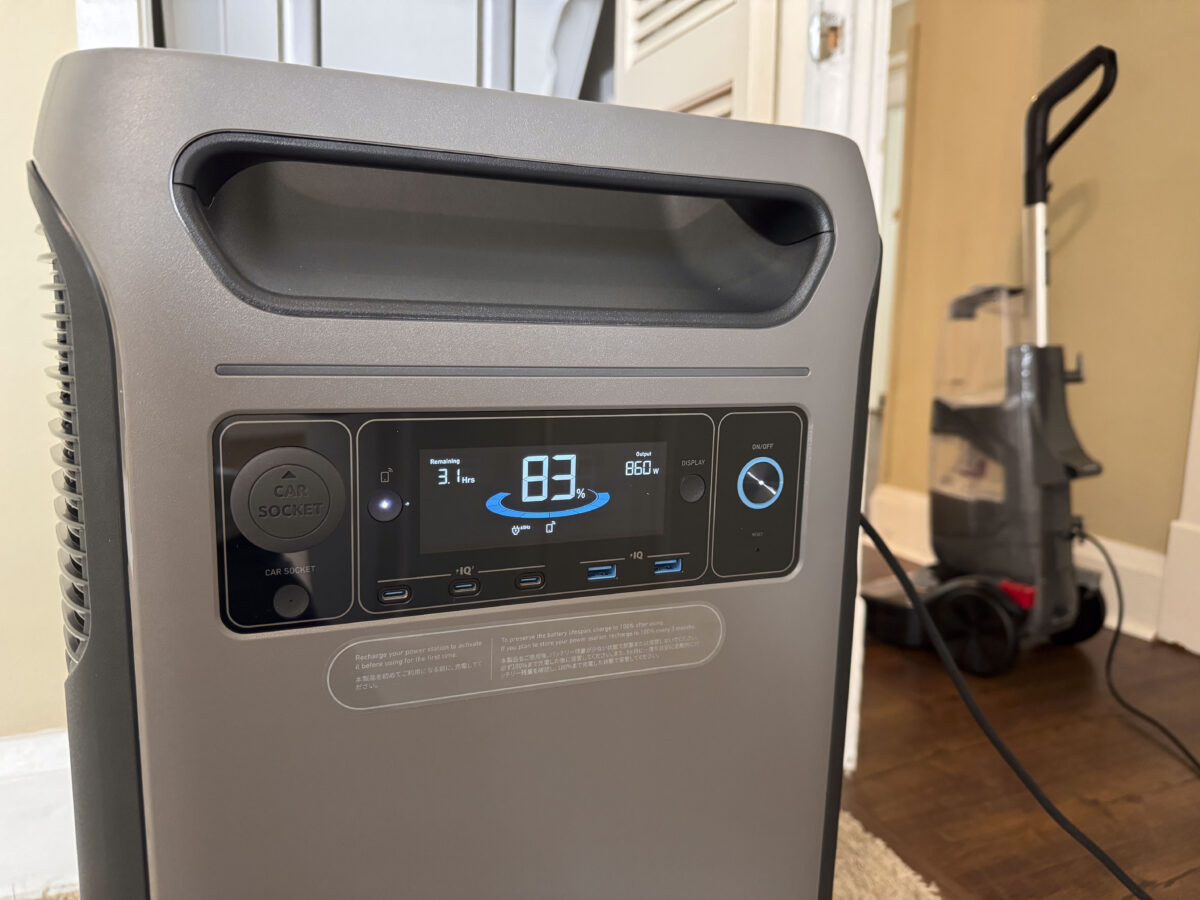Power Your Home, RV, and Electric Vehicle With the Anker Solix F3800
When your home’s power is threatened by storms and natural disasters, it’s nice to have a generator to keep your essential devices and appliances up and running. But what if there were a better way to achieve home backup power? Anker is proposing a solution with the Solix F3800 Portable Power Station. I’m going to run through its performance, design, and features so you know what to expect.
Note: Check out our Best Generator Reviews list to see some more of our favorite picks!
Pros
- Whole-home backup
- Stackable power design
- Solar or grid compatibility
- Remote app-based monitoring
Cons
- On the heavier side
Anker Solix F3800 Performance

- Model: Anker F3800
- Max power output: 6000W
- AC output: 120V
- Capacity: 3840 Wh
One of our staff recently got his rental property ready for the next tenants. During the time the power was off, he used the Anker F3800 to run a vacuum to clean the carpets throughout the entire home. Its high power capacity and portable design (more on that later) came in handy during the job. However, I wanted to dive in further on the rest of this unit’s features to give you an idea of what it would be like for whole-home power.
For starters, the Anker Solix F3800 achieves a max power output of 6000W to power a variety of appliances around your home. It has a dual AC output of 120V / 240V to power both regular and high-voltage appliances, and a battery capacity of up to 3840Wh.
You may be wondering what this translates to in terms of real-world application. Here are some common household appliances and their runtimes using an Anker Solix F3800 unit:
- LED bulb: 36.4 hours
- Microwave: 4.3 hours
- Fridge: 14.9 hours
- TV: 20.1 hours
- Laptop: 61.5 charges
- Vacuum: 2.6 hours
- Phone: 465.4 charges
- Window AC: 3.7 hours
Stackable Power
What’s really cool is this unit’s ability to stack power— either in the form of extra batteries or the addition of a second F3800 unit. With a power output of up to 3.8kWh in a single Solix F3800 unit, Anker estimates that you’d be able to power your home for around one day, based on the average daily electricity usage during a blackout.
With these same metrics, that output shoots up to 26.9kWh when you add in six additional batteries, which gives you an estimated 1 week of home power. Finally, if you want to go all out, you can add a second F3800 unit and six more additional batteries for a total of 12,000W and 53.8kWh, or two weeks of power.
Now, again, these estimates only consider the amount of home energy used during a blackout. The average U.S. home consumes around 30kWh per day, so the 6000W / 3840Wh of power output from a single Anker Solix F3800 unit probably won’t quite be enough on its own if you’re looking for whole-home energy replacement.
The main thing to keep in mind when extending your power during a blackout is prioritizing what you want to power. For instance, here in Florida, a hurricane might knock out power for a day or a whole week. In that case, the main priorities would be lights, fans, and fridges/freezers to keep food from spoiling. If you use a CPAP machine or another necessary medical device, those are top priorities for you too.
By the same token, if you’re confident an outage will only last a few hours, you might want to power your TV, internet, window AC, microwave, etc to keep your family comfortable while you wait. In this case, a single Solix F3800 unit would most likely take care of your needs. The key is to manage your available power capacity for the duration of the outage.
EV and RV Charging
This power station also lets you charge an electric vehicle. To do this, double-press the 240V switch to activate EV charging mode. Then, simply connect your EV charging cable to the NEMA 14-50 port to begin charging. Using this port, or the NEMA L14-30R port, you can also power the appliances in your RV.
Anker Solix Home Power Panel

The F3800 is the first portable power station to feature AC coupling, making it easier to power your home via solar panels. Simply plug into the grid with your Anker Solix Home Power Panel and connect it to your rooftop solar panel. You can even store excess solar energy for when you need it during an emergency or at night when energy costs are higher.
The Anker Solix Home Power Panel integrates your F3800 unit, the utility grid, and roof solar panels, letting you power your home while avoiding peak rate charges. Plus, in the case of a power outage, the Home Power Panel automatically switches on without you needing to manually turn on the switch.
While this process makes it easier to power your home during an outage, it’s not required for use with the F3800. You can still use a manual transfer switch if your home is already equipped with one.

Anker Solix F3800 Design

- Add up to 6 extra batteries for a capacity up to 26,880Wh
- Built-in NEMA 14-50 port for EV charging
- Suitcase design for easy transport
- Professional setup in as little as 1 hour
- Stackable— obtain up to 12,000W of output with two units
- First portable power station with AC coupling
The F3800 power station features a portable design, with front castor wheels and larger rear wheels, along with a telescoping handle to make maneuvering around easier. However, the 132-pound weight was a lot for me to handle at some points. If you’re planning on taking it upstairs or transporting it in a vehicle, you may need some help.

For power input and output, there are a total of six 120V 20A ports, with three being UPS (uninterruptible power supply) ports. When in UPS mode, only the three 120V ports labeled “UPS” are operational. Along with these, there is also a 240V port and a 25A port.
At the front next to the LCD display, you’ll find a 12V car socket, three USB-C ports, and two USB-A ports. Finally, there’s a NEMA 14-50 (100-120V), a NEMA L14-30R port, and two solar XT-60 ports.
Anker Solix F3800 Smart App Control

You can manage your power savings, customize your settings, and view your current battery levels using the Anker app. Once you download the app, you can connect your device via Bluetooth.
The app maximizes your energy savings by enabling you to view time-of-day and peak power shaving modes so you can gain energy independence when grid power is at its peak times.
Update After Hurricane Milton
We got a chance to use the Solix F3800 following Hurricane Milton which ran right overtop our shop and the nearby home of our editor-in-chief. We connected the F3800 to power a Bosch refrigerator—which it did handily for about 24 hours while we waited for power to be restored (it took 2 days). Once we connected our Generac 18000W generator to the home, we alternated between using the generator and the Anker Solix to supply power to the fridge.

Anker Solix F3800 Price
There are several configurations for this power station, so the price will vary based on the setup you choose. The base Solix F3800 unit retails for $3,999. You can also choose from several kits and add-ons, listed below:
- Anker Solix F3800 + Home Backup Kit – $4,598
- Anker Solix F3800 + Smart Home Power Kit – $5,237
- Anker Solix F3800 + Expansion Battery – $6,498
You can also choose anywhere up to three Solix Portable Solar Panels, and up to twelve Expansion Batteries to go along with your order. If you order an Anker Solix F3800 + Smart Home Power Kit, 3x Anker Solix Portable Solar Panels, and 12x Expansion Batteries, your total price would be $40,880 after any site discounts.
Anker backs each F3800 unit with a 5-year warranty.
Final Thoughts
If you’re ready to swap out your generator for something quieter, easier to use, and (in some cases) less expensive, consider the Anker Solix F3800. While a single unit may not give you the power you need for whole-home replacement, its stackable design and grid/solar compatibility make this a good investment as a starting point for your home’s energy independence.



